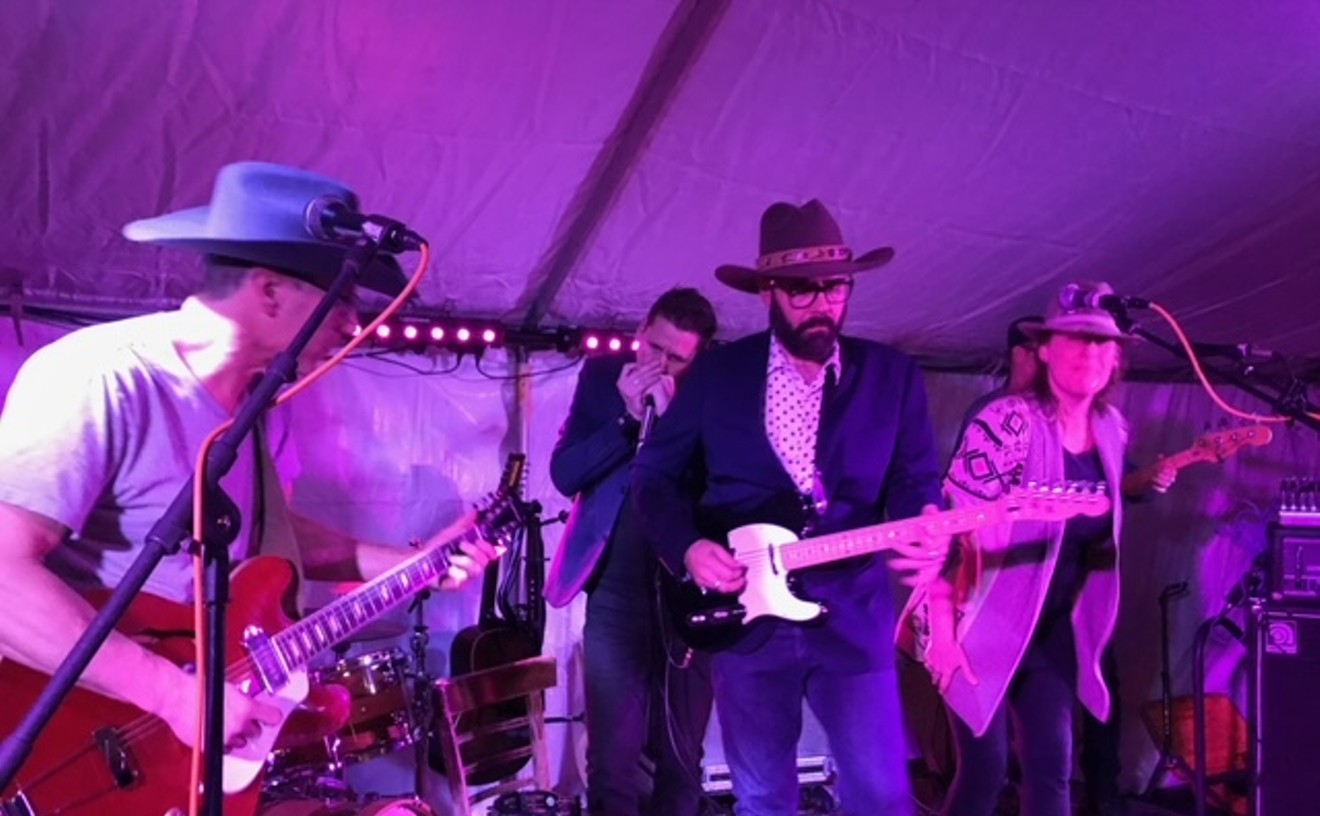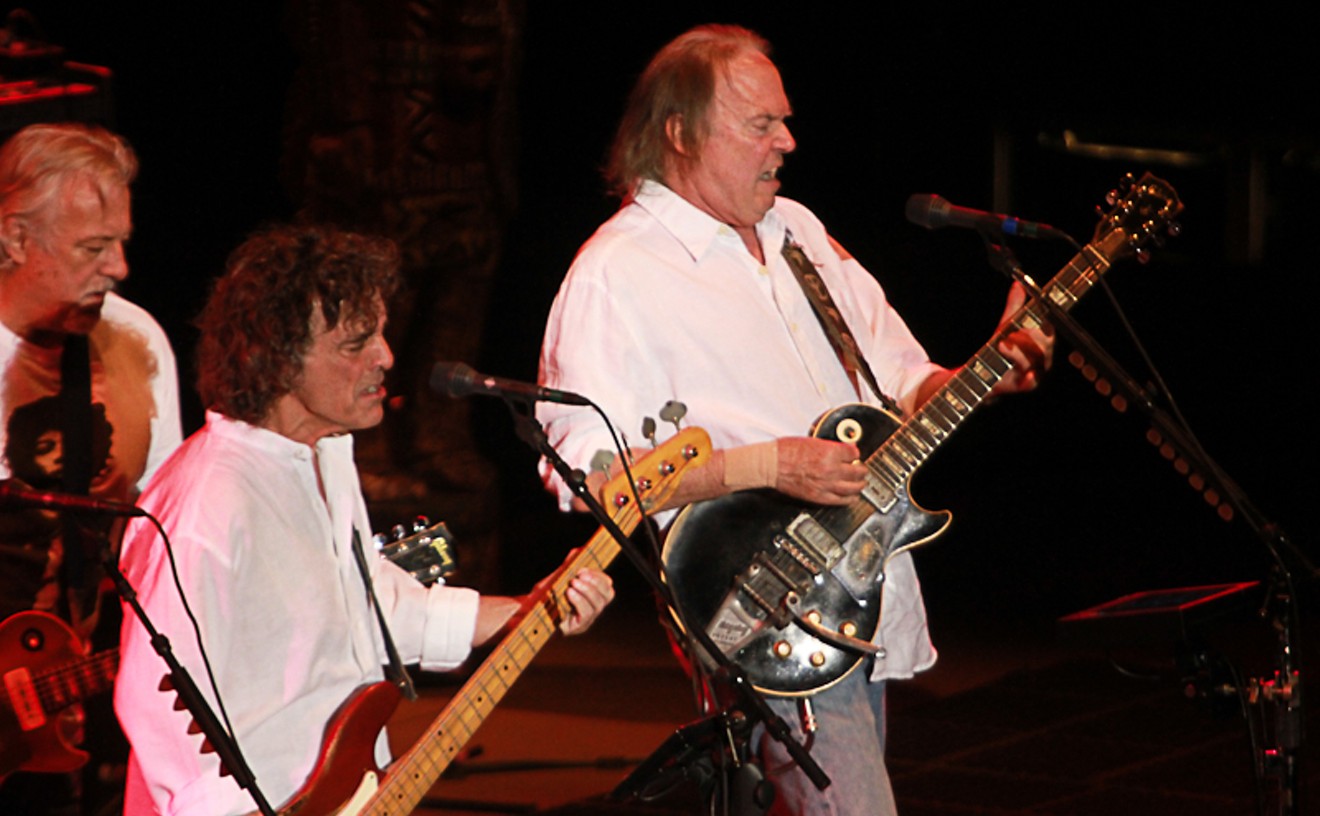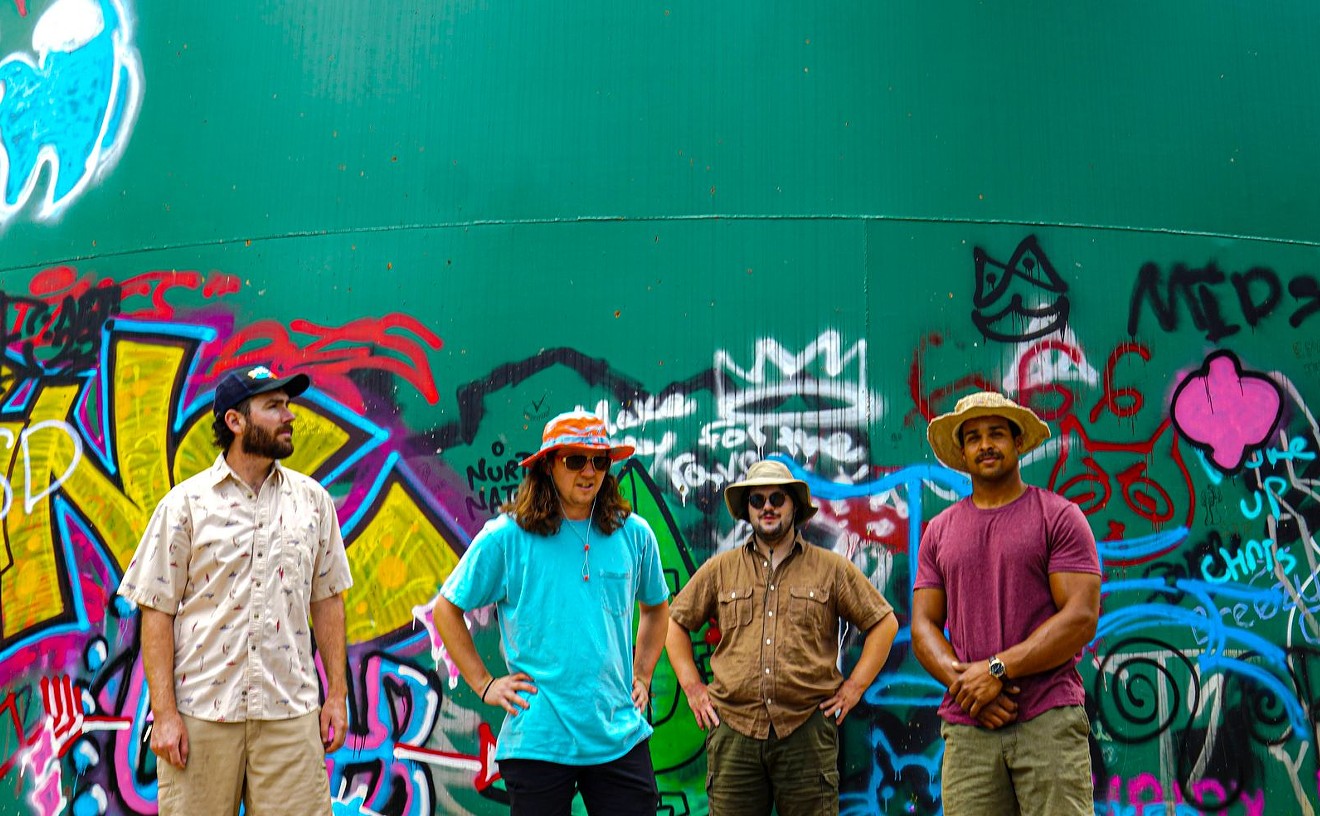Hugo Award-winning writer Jason Heller has written for the New Yorker, Rolling Stone, Pitchfork and the Atlantic Monthly. He’s been a Westword contributor for many years and is a familiar face on the Denver music scene, both as a DJ and now in his current band, Weathered Statues. For his new nonfiction book, Strange Stars: David Bowie, Pop Music, and the Decade Sci-Fi Exploded, Heller drew from his youth to explore a time of unparalleled creativity and determined that the nerds have been winning all along.
Here’s the introduction to Strange Stars:
The air was hot and charged with electricity as I threaded my way through the crowd at Mile High Stadium. It was August 12, 1987. I was fifteen. And I was there to see David Bowie.
I’d camped out for tickets a few weeks before that. Those were the pre-Internet days, when taking such drastic action was not just the best way to secure good seats at a concert, but the ideal method by which to flaunt your fandom. After standing in line for half a day, I snagged a coveted seventh-row ticket. All I had to do then was wait for August 12 to arrive — easier said than done, especially for a fidgety, high-strung teen.
I can’t remember a world without David Bowie in it. My mom had given birth to me when she was still in high school; in fact, August 12, 1987, was her thirty-first birthday. She was a child of the rock ’n’ roll age, and being a free-spirited ex-hippie, she flooded our household with music. It was mostly the radio — and rock radio in the ’70s and ’80s could not play Bowie enough. As popular as he’d become, though, he retained an overwhelming mystique. My mom also loved Lynyrd Skynyrd and Tom Petty, dressed-down rock stars you could easily imagine bumping into at the supermarket. The thought of seeing Bowie at Safeway seemed absurd. He wasn’t from here. He wasn’t of Earth.
Being like any other reasonable kid who had reached his teens, I rejected the music my mom listened to. Bowie, however, was the exception. Sure, his music belonged to the generation before me. But he’d also reinvented himself in the early ’80s as a creature of that decade, one who was both an honored forefather and a vital contemporary of all the new wave artists I loved. One of those bands, Duran Duran, was opening for Bowie that night at Mile High Stadium. They were at the height of their popularity, and I was excited beyond belief to see them. But the gravity belonged to Bowie.
There was another reason why Bowie appealed to me, apart from his ability to remain cutting-edge over twenty years into his career as a recording artist. More than any other singer or band I knew of, he embodied something else I loved, something that, by the age of fifteen, had become stamped onto my psyche as an inextricable part of my identity: science fiction.
I saw Star Wars during its first run in the summer of 1977. My grandmother managed a tiny single-screen movie theater in a strip mall in Englewood, Florida, and it was there that one of the defining moments of my life occurred. It’s almost embarrassing today to speak so glowingly about seeing Star Wars. The experience has been shared so many times, by so many people, it’s become rote. That doesn’t soften the impact that movie had on me: it filled my entire body, it seemed, with its images and movements and ideas and sounds. I reveled, even at that young age, in its contradictions. It was futuristic, yet it happened in the past. The technology was advanced, yet it was grimy. I had grown up watching reruns of Star Trek with my grandfather, but this was nothing like that shiny, gleaming, immaculate tableau. Star Wars felt lived-in. As such, it was a place kids could imagine living in. And becoming so much more than they already were.
One of the first records I remember owning was Meco’s Star Wars Theme/Cantina Band. Being 1977, disco was huge, and I heard those hypnotic beats on the radio just as much as Southern rock. The fact that the orchestral music from Star Wars had been turned into disco struck me as profound. I wasn’t aware of who made that music or how they did it. But I was shown the eye-opening idea that movies and music were able to have a conversation, and that songs could be a vehicle for science fiction. By the end of the ’70s, my ear glued to the radio, I’d begun cataloging such songs in my head: “Rocket Man” by Elton John, “Iron Man” by Black Sabbath, “Space Cowboy” by Steve Miller Band, and a particularly enthralling tune about a wayward astronaut named Major Tom.
In 1969, Bowie released his sci-fi anthem, Space Oddity. In 1980, he released its sequel, Ashes to Ashes. Both starred Major Tom, a spaceman who’d become trapped in his ship, adrift in nothingness, never to touch Earth again. These two songs also neatly bookended the ’70s, the decade when sci-fi music came of age.
Bowie had not been the first to sing about space travel. Throughout the ’50s and ’60s, scores of novelty songs depicted comedic visits from aliens — and although his music was instrumental, the jazz bandleader Sun Ra imbued his albums with cosmic titles, ideas, and sounds. But it wasn’t until the late ’60s that popular music began taking sci-fi seriously. Granted, it was a time when sci-fi began taking itself more seriously; the age of pulp had faded, and a raft of revolutionary new films and novels were reimagining what sci-fi could do and be.
Stanley Kubrick’s 2001: A Space Odyssey and Samuel R. Delany’s Nova, both from 1968, were among the works that brought fresh depth, nuance, and sophistication to sci-fi. Emboldened, musicians with latent sci-fi tendencies began to follow suit: the Byrds, Jimi Hendrix, Jefferson Airplane, Pink Floyd.
It was Space Oddity, though, that launched sci-fi music in earnest. Released to coincide with and capitalize on the Apollo 11 moon landing — while also hinting at the title of Kubrick’s movie from the year before — the song didn’t just contain sci-fi lyrics. Sonically, it was a reflection of sci-fi, full of futuristic tones and the innovative manipulation of studio gadgetry.
Space Oddity set off a chain reaction. The ’70s began with a wave of progressive rock bands — from hit-makers like Yes to obscure acts like Magma — working sci-fi into their music. Other genres of music followed, each incorporating the motifs of aliens, robots, space exploration, artificial intelligence, and dystopianism in different ways: Krautrock, glam, heavy metal, funk, disco, post-punk. A wholly original school of electronic music emerged. Artists developed and assimilated new technology in the effort to make music sound more like tomorrow: synthesizers, voice modulators, drum machines, samplers. Running parallel to this music were dramatic developments — and setbacks — in the space program, as well as a proliferation of books, films, and eventually video games that changed the face of sci-fi forever.
Star Wars is the first movie that springs to mind when thinking about ’70s sci-fi, and Bowie is the first musician. Both are touchstones of the decade’s pop culture. As I grew older and became more immersed in sci-fi of all media, though, I began to realize how isolated sci-fi music was. Literature and cinema were taken as serious sci-fi and discussed openly as such; sci-fi music, on the other hand, was still seen as sort of a novelty. After I grew to adulthood and got into music journalism, that out-of-hand dismissal began to frustrate me. The Hugo Awards, sci-fi’s highest accolade, honored books, films, and television every year; only on the rarest of occasions did they acknowledge the contribution to the sci-fi canon made by music. When the openly sci-fi songs of artists like Bowie did pop up in the sci-fi discourse, the conversation swiftly pivoted to something else — as if a thorough analysis of sci-fi’s influence on music was either tangential or trivial.
I should have been used to it. I grew up before the geek revolution of the twenty-first century, during the ’70s and ’80s when sci-fi was largely snubbed and dismissed by critics. Good sci-fi, rare as it was, succeeded in spite of being sci-fi: that was the unspoken premise underlying mainstream criticism of the genre. That prejudice carried over to sci-fi music. There were welcome exceptions: Paul Williams, Lester Bangs, Simon Reynolds, and Kodwo Eshun are among the small circle of critics and thinkers over the years who embraced the overlap between sci-fi and popular music. Still, I was at a loss for something that fit all the pieces together — that told the tale of how sci-fi music came to be.
I dreamed up the idea for Strange Stars in 2015. Two years earlier, I’d contributed an essay about the influence of sci-fi writer J. G. Ballard on the post-punk scene of the late ’70s and early ’80s to Adventure Rocketship!, a literary journal published by British editor Jonathan Wright. The entire journal was filled with interviews and essays about sci-fi musicians as varied as Mick Farren, Boney M., Parliament, and Be-Bop Deluxe. It was a patchwork, as all good journals are. But rather than slaking my desire for the story of sci-fi music, it whetted it.
Strange Stars was already under way when Bowie died in January of 2016 of liver cancer. There had been no forewarning; Bowie, up until the end, maintained his mystique. I’d never felt the passing of a celebrity with such a sense of loss. It was intensified by the release of Blackstar, his final album, which came out two days before his death. Not only was it an incredibly powerful album, it was a return to sci-fi — something Bowie had dipped into only occasionally since the heyday of sci-fi music in the ’70s. Strange Stars was written in the shadow of his absence, in the void he left.
The story is about more than Bowie, though. His relationship with sci-fi throughout the ’70s was a complicated one, and its convoluted path threads throughout the larger tale of that decade’s sci-fi music. His story crosses over with those of Hawkwind and T. Rex and Kraftwerk and Devo and the Human League and any number of other artists of the ’70s who speculated about the reality of the present or probed the possibilities of the future. Some of them were cult heroes who persisted in singing about outer space when it was obvious career suicide; others were platinum-selling opportunists who jumped on the sci-fi bandwagon the minute it became profitable. Both, to me, are valid and important to the discussion — not only of sci-fi music but of how ’70s pop culture forged a special interface with the future. That story begins and ends with two songs about an astronaut named Major Tom: “Space Oddity” and “Ashes to Ashes” — how they came about, what they meant, who they inspired, and why so much happened in the decade between them.
As the applause died and the crowd of thousands dispersed through the gates of Mile High Stadium, I tried to wrap my head around what I’d just witnessed. Later I’d learn that Bowie’s Glass Spider Tour of 1987 was generally considered by critics to be a flop, a bloated and excessive spectacle barely able to disguise the shortcomings of an aging rock star in decline. The magazine Smash Hits summed it up pointedly: “If Dame David Bowie is such a bleeding chameleon, why, pray, can’t he change into something more exciting than the skin of an aging rock plodder?”
That’s not what I saw that night. I saw David Bowie descend sixty feet from a giant spider while lounging in an office chair, casually reciting the ominous opening lines of his song “Glass Spider.” I saw a tornado of catsuits, astronaut costumes, and gold lamé. I saw him perform a song from his 1974 sci-fi masterpiece Diamond Dogs: “Big Brother,” which had originally been intended for a combination album-and-stage adaptation of George Orwell’s Nineteen Eighty-Four. I saw, in short, a songwriter who loved the wonder and fear and fun and transformation of science fiction — and who, against all odds, had passed that love along to millions. In doing so, he compelled a decade’s worth of fellow travelers to explore the farthest reaches of music along with him.
Introduction to Jason Heller’s Strange Stars: David Bowie, Pop Music, and the Decade Sci-Fi Exploded reprinted with the permission of the author and Melville House Publishing.
See Jason Heller at 7 p.m. Tuesday, July 3, at a discussion of his book and a screening of A Clockwork Orange at the Sie FilmCenter; at 6:30 p.m. Friday, July 6, at a talk about Strange Stars at Mutiny Information Cafe; or at 2 p.m. Saturday, July 7, at a combo book-signing/DJ set at the Central Denver Public Library. Find out more about Strange Stars at jasonhellerauthor.com.
[
{
"name": "Air - MediumRectangle - Inline Content - Mobile Display Size",
"component": "12017618",
"insertPoint": "2",
"requiredCountToDisplay": "2"
},{
"name": "Editor Picks",
"component": "17242653",
"insertPoint": "4",
"requiredCountToDisplay": "1"
},{
"name": "Inline Links",
"component": "18838239",
"insertPoint": "8th",
"startingPoint": 8,
"requiredCountToDisplay": "7",
"maxInsertions": 25
},{
"name": "Air - MediumRectangle - Combo - Inline Content",
"component": "17261320",
"insertPoint": "8th",
"startingPoint": 8,
"requiredCountToDisplay": "7",
"maxInsertions": 25
},{
"name": "Inline Links",
"component": "18838239",
"insertPoint": "8th",
"startingPoint": 12,
"requiredCountToDisplay": "11",
"maxInsertions": 25
},{
"name": "Air - Leaderboard Tower - Combo - Inline Content",
"component": "17261321",
"insertPoint": "8th",
"startingPoint": 12,
"requiredCountToDisplay": "11",
"maxInsertions": 25
}
]













